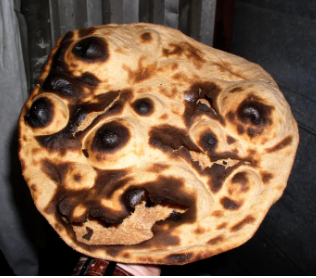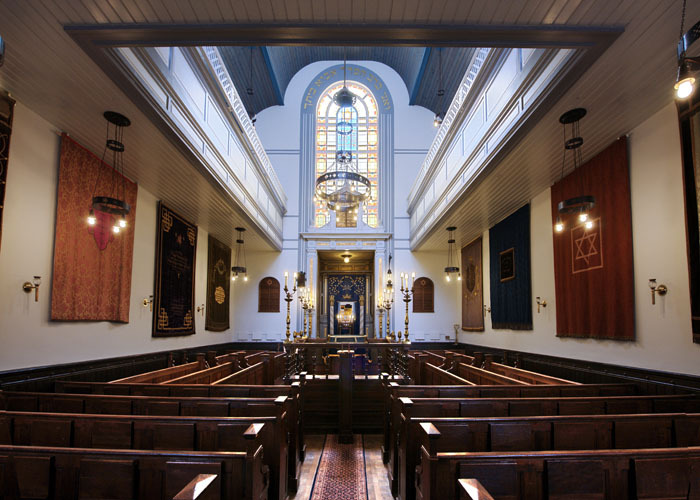(כב) וַיְהִ֣י ׀ בַּיּ֣וֹם הַשִּׁשִּׁ֗י לָֽקְט֥וּ לֶ֙חֶם֙ מִשְׁנֶ֔ה שְׁנֵ֥י הָעֹ֖מֶר לָאֶחָ֑ד וַיָּבֹ֙אוּ֙ כׇּל־נְשִׂיאֵ֣י הָֽעֵדָ֔ה וַיַּגִּ֖ידוּ לְמֹשֶֽׁה׃ (כו) שֵׁ֥שֶׁת יָמִ֖ים תִּלְקְטֻ֑הוּ וּבַיּ֧וֹם הַשְּׁבִיעִ֛י שַׁבָּ֖ת לֹ֥א יִֽהְיֶה־בּֽוֹ׃
(22) On the sixth day they gathered double the amount of food, two omers for each; and when all the chieftains of the community came and told Moses (26) Six days you shall gather it; on the seventh day, the sabbath, there will be none.”
וחייב אדם לבצוע על שתי ככרות בשבת וביום טוב... ותניא במיכלתי "ששת ימים תלקטוהו וביום השביעי שבת לא יהיה בו", למדנו למן שלא היה יורד בשבת, ימים טובים מניין ת"ל שבת לא יהיה בו, פי' בכל יום הנקרא שבת לא יהיה בו המן. למדנו שלא היה המן יורד לא בשבתות ולא בימים טובים, וכל שעה שמבקש לסעוד חייב בלחם משנה
אָמַר רַב פָּפָּא: הַכֹּל מוֹדִים בְּפֶסַח, שֶׁמַּנִּיחַ פְּרוּסָה בְּתוֹךְ שְׁלֵמָה וּבוֹצֵעַ. מַאי טַעְמָא? — ״לֶחֶם עֹנִי״ כְּתִיב.
This resolution is reinforced in a unique case, as Rav Pappa said: Everyone agrees that while fulfilling the mitzva of eating matza on Passover, one places the piece inside the whole and breaks. What is the reason? With regard to matza the phrase “Bread of affliction” (Deuteronomy 16:3) is written, and the poor typically eat their bread in pieces. Therefore, eating matza on Passover evening, the broken matza is also significant.
לחם עוני כתיב – ודרכו של עני בפרוסה לפיכך צריך שיראה כבוצע מן הפרוסה:
רב שרירא ז"ל:
(ב) אנשי מזרח בוצעין על שתי ככרות בשבת משום לחם משנה אנשי א"י אין בוצעין אלא על אחת שלא להכניס כבוד ערב שבת בשבת והלכה רווחת היא בכל מקום שאין בוצעין בשבת ובימים טובים אלא על שתי ככרות ובליל פסח על אחת וחצי והן כמו שתי ככרות משום לחם עוני שהיא החצית וביום אסור דקי"ל ההוא לחם עוני בזמן אכילת הפסח, ופסח אינו נאכל אלא בלילה, וכתיב "תאכל עליו מצות לחם עוני"; על הפסח לחם עוני והוא בלילה, שאני ביום דלא צריך פסח ולא צריך לחם עוני
וְלוֹקֵחַ שְׁנֵי רְקִיקִין וְחוֹלֵק אֶחָד מֵהֶן וּמַנִּיחַ פָּרוּס לְתוֹךְ שָׁלֵם וּמְבָרֵךְ הַמּוֹצִיא לֶחֶם מִן הָאָרֶץ. וּמִפְּנֵי מָה אֵינוֹ מְבָרֵךְ עַל שְׁתֵּי כִּכָּרוֹת כִּשְׁאָר יָמִים טוֹבִים מִשּׁוּם שֶׁנֶּאֱמַר (דברים טז ג) "לֶחֶם עֹנִי" מַה דַּרְכּוֹ שֶׁל עָנִי בִּפְרוּסָה אַף כָּאן בִּפְרוּסָה...
He takes two cakes [of matzah], divides one of them, places the broken half inside the whole [cake] and recites the blessing, hamotzi lechem min ha'aretz.
Why does he not recite a blessing on two loaves, as on other festivals? because [Deuteronomy 16:3] states "the bread of poverty." Just as a poor man is accustomed to eating a broken [loaf], so, too, a broken loaf should be used.
בַּזְּמַן הַזֶּה שֶׁאֵין שָׁם קָרְבָּן, אַחַר שֶׁמְּבָרֵךְ הַמּוֹצִיא לֶחֶם חוֹזֵר וּמְבָרֵךְ עַל אֲכִילַת מַצָּה. וּמְטַבֵּל מַצָּה בַּחֲרֹסֶת וְאוֹכֵל...
At present, when there is no [Paschal] sacrifice, after one recites the blessing, hamotzi lechem, one then recites the blessing, al achilat matzah, dips the matzah in charoset, and eats it.
רב כהן צדק ז"ל
...ואיכא מרבוותא דאמרי דכיון דשתיהן מחוייבות לברכת המוציא, היאך תצא אחת מהן לברכה אחרת לברך עליה "אכילת מצה" דהא חזינן דעל נהמא לא מברכין תרי ולא אתחייב בתרתי ברכאן. אלא אוחז שתי ככרות שלימות ופרוסה מאותן פרוסות ההיא דאגביהה ואמר "מצה זו" וכיון דאגביהה לשם מצה, עלה מברך ברכת מצה דהא זימנה לברכת מצה ואמר מצה זו, זו ולא אחרת, ועל אותן שתי ככרות שלימות מברך המוציא... ואוכלין ההוא עליונה מאותן שתים שלמות לשם "מוציא" והפרוסה לשם "מצה" ואחרת מניח לה "לכרוך עם החזרת" בלא ברכה וכורך אותה עם המרור
“There’s lots of textual proof that matzah in Talmudic times was softer and thicker,” says Rabbi Dr. Ari Z. Zivotofsky. “Back then the matzot looked like pitot.” OU Rabbinic Coordinator Rabbi Avrohom Juravel also notes that the Shulchan Aruch refers to a matzah that is a “tefach thick,” which is about three or four inches thick.
A benefit is that soft matzot are indisputably deserving of the Hamotzi blessing. As for hard cracker matzot (known in halachic parlance as rekikim), some Sephardic posekim, including Rabbi Ovadiah Yosef, maintain that they get the berachah of Mezonot. And not only Sephardic posekim maintain this position. The Tzitz Eliezer, Rabbi Eliezer Waldenberg, a well-respected twentieth-century Ashkenazi posek, debated whether Hamotzi should be recited over hard matzot, ultimately justifying the berachah on the grounds that the matzah forms the basis of the meal. (The debate over the blessing on matzah is relevant year round, not just on Pesach.)
How do soft matzot achieve their soft texture? It’s all about the water. “Generally speaking, the less water, the harder and drier the matzah will be,” states Rabbi Avraham Manning. Soft matzah bakers routinely add more than twice the amount of water used in hard matzot, making the dough pliable, he explains. Contemporary soft matzot are factory baked, wrapped in plastic and stored in the freezer. (These matzot must be defrosted immediately before being served.)
Already hundreds of years ago, due to urbanization and other factors, matzah began to be produced well in advance of the holiday. Because of the long storage period, matzot were made thinner and drier so they would last. At the same time, some posekim also encouraged a thinner product fearing that thicker matzot might contain unbaked dough, which could turn to chametz. This is a serious halachic concern. “The thicker the matzah, the more likely the dough inside is not baked well,” explains Rabbi Juravel. “If water intermingles with the unbaked flour, the matzah becomes pure chametz.” Therefore, most Ashkenazic posekim are opposed to Ashkenazim consuming soft matzah on Pesach. Rav Schachter, however, does permit soft matzos on Pesach. His position is that one may eat soft matzas so long as they are from a reliable Sephardic hechsher that has a tradition on how to bake these matzas.
Yom Tov Tzemah, a representative from the Alliance Israelite Universelle, who visited Yemen in 1920, noted that while the soft matzot the Yemenites baked during the holiday were far tastier than the Ashkenazi cracker variety, the twice daily baking schedule was grueling for the bakers—most of them female. “What is the life of the women here, if not sadness and work?” he wrote
[jewishaction.com]

נהגו העולם לעשות מצה של חובה דקה ומ"מ איפשר דבדיעבד לא אסרו עד טפח
תַּנְיָא, רַבִּי אֱלִיעֶזֶר אוֹמֵר: חוֹטְפִין מַצּוֹת בְּלֵילֵי פְּסָחִים בִּשְׁבִיל תִּינוֹקוֹת שֶׁלֹּא יִשְׁנוּ.
One grabs the matzot on the nights of Passover. One should eat them very quickly on account of the children, so that, due to the hasty consumption of the meal, they will not sleep and they will inquire into the meaning of this unusual practice.
חוטפין מצה - …ואית דמפרש חוטפין מצה אוכלין מהר וזה הלשון עיקר מדמייתי הא דר"ע בהדה:
עַד הֵיכָן הוּא אוֹמֵר, בֵּית שַׁמַּאי אוֹמְרִים, עַד אֵם הַבָּנִים שְׂמֵחָה. וּבֵית הִלֵּל אוֹמְרִים, עַד חַלָּמִישׁ לְמַעְיְנוֹ מָיִם. וְחוֹתֵם בִּגְאֻלָּה.
[*בית שמאי אומרים כו' ובית הלל אומרים כו'. נ"ל דכ"ע סברי רוב הלל אחר מזונו וכדתניא [דף ק"ט ע"א] רבי אליעזר אומר חוטפין [אוכלין מהר] מצות בלילי פסחים בשביל תינוקות שלא יישנו ותניא ר' עקיבא בעַרְבֵי פְסָחִים היה אומר הגיע עת לעמוד מבית המדרש בשביל תינוקות שלא יישנו וקסברי בית שמאי דיש למהר ולא לומר קודם המזון רק מזמור א' וב"ה סברי כיון דבמזמור הראשון לא נזכר קריעת ים סוף צריך שיאמר גם השני שיש בו הזכרת קריעת ים סוף כיון שאומר אח"כ ברכת הגאולה כי לא נושעו ישראל מיד מצרים עד שנקרע להם הים ונטבעו המצרים ושם נאמר ויושע וגו'
וְצָרִיךְ לַעֲשׂוֹת שִׁנּוּי בַּלַּיְלָה הַזֶּה כְּדֵי שֶׁיִּרְאוּ הַבָּנִים וְיִשְׁאֲלוּ וְיֹאמְרוּ מַה נִּשְׁתַּנָּה הַלַּיְלָה הַזֶּה …חוֹטְפִין מַצָּה זֶה מִיַּד זֶה וְכַיּוֹצֵא בִּדְבָרִים הָאֵלּוּ.
He should make changes on this night so that the children will see and will [be motivated to] ask: "Why is this night different from all other nights? …matzot should be snatched from each other and the like.
אָמַר רַבָּה: בַּעַל נֶפֶשׁ לֹא יִלְתּוֹת. מַאי אִירְיָא בַּעַל נֶפֶשׁ? אֲפִילּוּ כּוּלֵּי עָלְמָא נָמֵי, דְּהָא תַּנְיָא: אֵין לוֹתְתִין שְׂעוֹרִין בַּפֶּסַח! הָכִי קָאָמַר: בַּעַל נֶפֶשׁ — אֲפִילּוּ חִיטִּין דִּשְׁרִירִי לֹא יִלְתּוֹת.
בעל נפש - חסיד:
דשרירן - קשים:
הכי קאמר אפילו חיטי - שהן קשין משעורין ואין ממהרין להחמיץ בעל נפש לא ילתות, אבל דלאו בעל נפש, דלא מחמיר על נפשיה כולי האי:
לְתִיתָה f. (לָתַת) moistening the grain before grinding
הֲדַר אָמַר רָבָא: מוּתָּר לִלְתּוֹת. דְּתַנְיָא: יוֹצְאִין בְּפַת נְקִיָּה וְהַדְרָאָה, וְאִי אֶפְשָׁר נְקִיָּה בְּלֹא לְתִיתָה.
והדראה - קִיבָר: קִיבָר m. (cibarium) the coarser meal which remains after the fine wheat flour
There are two requirements in the "ingredients" of a matza
1] That it should be made from the "Five Grains," which are Wheat, Barley, Spelt, Oats, and Rye. Based on this, it receives a status of "Lechem" [bread]. Matzot must be a "Lechem Oni."
2] It must be made from an ingredient that is "ra'uy lehachamitz," which means that it is "potentially" able to become chametz - and because it is watched and baked in haste, never did actually become chametz.
Wheat can become chametz, but the bran part cannot. A matza which is "mostly" bran, may not be used. A matza made of mostly bran would lack the first of the conditions that a matza must be a "lechem" a bread. When using whole wheat matzot that are "mostly wheat," no added matzah for the shiur 'Kazayit" is needed to compensate for the bran part. This only holds if the whole wheat is from the entire wheat ground in its original form.
(ג) אין לברך קודם שיתפוס הלחם:
(ד) יתן שתי ידיו על הפת בשעת ברכה שיש בהן י' אצבעות כנגד י' מצות התלויות בפת ולכך יש י' תיבות בברכת המוציא וי' תיבות בפסוק מצמיח חציר לבהמה וי' תיבות בפסוק עיני כל אליך ישברו וי' תיבות בפסוק ארץ חטה ושעורה וי' תיבות בפסוק ויתן לך:
(ה) לא יבצע עד שיביאו לפניו מלח או ליפתן (פירש"י כל דבר הנאכל עם הפת) ללפת בו פרוסת הבציעה הגה ומ"מ מצוה להביא על כל שלחן מלח קודם שיבצוע כי השלחן דומה למזבח והאכיל' לקרבן ונא' על כל קרבנך תקריב מלח (ב"י בשם שבולי הלקט) והוא מגין מן הפורענות
(3) Do not bless "Hamotzi" before grasping the bread.
(4) Put both hands on the bread when you are about to bless "Hamotzi"; for the 10 fingers are reflective of the 10 mitzvot that are dependent on bread. Additionally, there are 10 words in the blessing of "Hamotzi" and 10 words in the following verses: Psalms 104:14, "He causes the grass to grow for the cattle, and grass for the service of man: that he may bring forth bread out of the land." Psalms 145:15, "The eyes of all look to you expectantly, and you give them their food at the proper time." Deuteronomy 8:8, "A land of wheat and barley, of vines, figs, and pomegranates, a land of olive trees and honey." Bresheit 27:28, "May G!d give you from the dew of heaven and fat of the earth, and an abundance of grain and wine."
(כג) יתן שתי ידיו - היינו דטוב לעשות כן. ואם הוא לבוש בבתי ידים נכון שיסירם בשעת הברכה. כתבו האחרונים כשיאמר השם יגביה הככר ובשבת שמברכין על שתים יגביה שתיהם:
(כז) מלח או לפתן - כדי שתהא נאכלת בטעם משום כבוד הברכה




